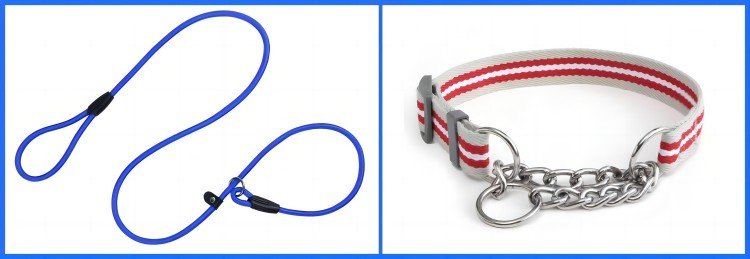Are you ready to walk your dog? Let’s figure out which one works best for both of you: a leash, a collar, or a harness.
We all know that using the wrong dog walking gear can lead to serious problems.
Some small dogs can suffer chest injuries, hair loss, or skin irritation from poorly fitted gear. Big dogs might pull so hard that they drag their owners down, leading to falls and injuries. Even worse, constant pressure on a dog’s neck can cause a collapsed trachea or other breathing issues. These aren’t rare cases—you see them in the news all the time.
That’s why it’s so important to know how to choose the right setup. In this guide, we’ll walk you through the differences between slip leashes, martingale collars, and harnesses—so you can find what’s safest and most comfortable for your dog.
Slip Leashes vs Martingale Collars

Most dog owners should say no to slip leashes (also known as P-collars). It’s called a P-collar because the looped leash makes a “P” shape when placed over the dog’s neck, and is often used in professional dog training.
One side is a loose loop that tightens when the dog pulls. It may feel like nothing when relaxed, but when pulled, it keeps tightening with no limit. If used the wrong way, the pressure can hurt a dog’s neck—especially if they try to run forward or backward. That’s how trachea injuries happen.
Even worse, dogs don’t feel pain like humans. So they’ll keep charging ahead, even if the collar is choking them. That’s why many dogs still pull, even with a slip leash.
Unless you’ve been trained to use one, skip the slip leash. It’s not for casual use.
On the other hand, regular collars and martingale collars are much more beginner-friendly.
The martingale collars still tightens a little, but only halfway. That makes it a great choice for slightly stubborn dogs. It gives just enough pull to remind your dog to behave, but without hurting them. If your dog is mostly well-behaved with occasional mischief, this is a smart pick.
Front-Clip No-Pull Harness

So what if your dog really pulls hard on walks?
If you’ve got a strong or stubborn pup, a front-clip no-pull harness could be your new best friend. This type of harness gives you more control by redirecting your dog’s movement—kind of like using reins on a horse.
When your dog pulls, the front clip gently turns them toward you instead of letting them charge ahead. It’s a favorite among professional dog trainers because it helps improve safety and control. It’s especially helpful for dogs with neck problems, or for pups that just don’t listen during walks.
What About Regular Harnesses?
Let’s talk about regular back-clip harnesses, too.
These were originally designed for sled dogs—so, yep, they’re meant to help dogs pull. If you use one on a strong dog, they may start pulling you like a sled.
Some cheaper designs even cause skin damage under the arms or make dogs overheat. They’re also tricky to put on.
Unless your dog walks gently and calmly, a standard harness may not give you enough control.
Now you know the risks of using the wrong leash setup. The right choice can protect your dog’s health—and save you from getting dragged across the sidewalk.
So choose smartly, test the gear on a walk, and make sure both you and your dog feel safe and comfortable. If this helped you, share it with other dog parents!








